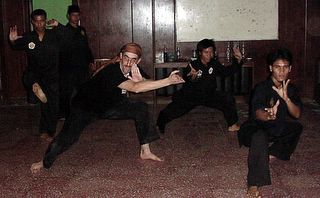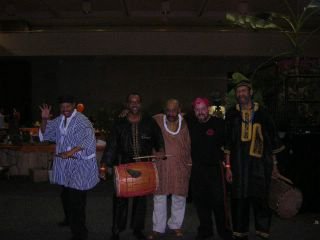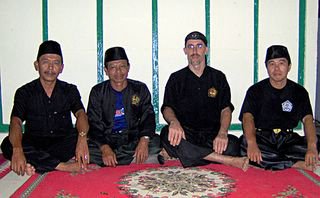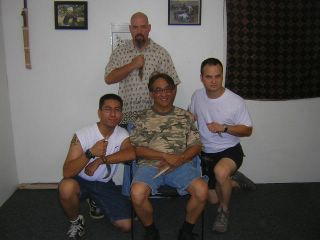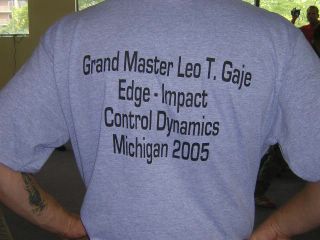I've had several requests for copies of this interview conducted by Ustaz Hussein in the currently under-construction section of his website. So, with his kind permission I reproduce it here.RCAG Interview with Guro Jeff Davidson of Pekiti Tirsia
RCAG: Salam Aleykum Guro
Guro Jeff: Aleykum Salam
RCAG: Guro, thank you for taking the time to have this interview with us.
RCAG: Guro Jeff, please tell us what exactly led you to the path of the
Silat Arts?
Guro Jeff: Initially, I was attracted to the "exotic-ness" of it all. I actually
began my journey into the Southeast Asian fighting disciplines with
Pangasinese Escrima after almost 10 years of practicing Chinese, Japanese
and Korean martial arts. I was searching for the roots of the empty-handed
system that would compliment my weapons training. Silat fascinated me -
especially the "internal aspect." I remember thinking: "This is so beyond
me, I will probably never get good at this. If I can only LEARN it, that
would be enough."
RCAG: What reason or reasons made you decide to change paths and join the
Pekiti Tirsia organization?
I have not changed paths at all! I am still powerfully focused on developing
myself to the best of my ability, and providing the highest standard of
training for those who study with me. This has always been my motivation
since the earliest days of my involvement in the martial arts. I believe
that one's first responsibility is to himself - in terms of growth. When one
reaches a certain level of comfort in his practice, it usually means he is
no longer being challenged. Progress in the martial arts is based onchallenge. A Master may not feel the need to accept challenges from other
fighters, but you cannot avoid your own need to grow, and leave your comfort
zone. This does not mean you need to learn a new batch of techniques! It
means you must seek out that which will push you to the next level. In my
case, Supreme Grand Tuhon Gaje "pushed" me farther during a single sparring
session than I had been in approximately 10 years!
RCAG: What are some combative principles of Pekiti Tirsia?
Pekiti Tirsia as we know it, is developed and refined by Supreme Grand Tuhon
Leo T. Gaje, who is connected to the realities of combat in a way most
people who do not live in a war zone ever will be. He has not only survived
the violent circumstances of his past, but he has elevated his skill to an
almost unbelievable level, which is acknowledged by his peers, supporters,
and even detractors. And he is still in the war zone to this day. I would
say that the principles of Pekiti Tirsia are a virtual 'Bible' of combat
against multiple, armed opponents - based on real-life encounters. The
techniques of Pekiti Tirsia (especially the way Tuhon is teaching them now)
represent the most effective and efficient means of applying those
principles. In almost 20 years of teaching martial arts, I have never seen
a system produce deadlier fighters in as short a period of time as Pekiti
Tirsia.
RCAG: What if anything is your speciality in the system i.e. knife, sword
etc.
I think it is important NOT to specialize in a particular weapon or
technique, as this can make you over-developed in some aspects of the Art
and under-developed in others. When I studied music in high school, I used
to sneak into clubs (being under aged) to take in the local music scene. I
remember being quite taken with a particular guitarist, who played with an
amazing virtuosity in several musical genres - jazz, rock, country, blues,
etc. I approached him after a performance and asked him: "Are you a jazz
player? Or a rock player? Or a blues player?" He chuckled and said "Nah,
kid...I'm just a player." In my opinion, just because you have a certain
proclivity towards say, the blade - you run the risk of being skillful with
that weapon, without really understanding the principles of combat in the
larger sense. That being said, my favorite weapon is the knife; my first
choice in an actual fight would be the stick; against multiple opponents I
would choose the staff; and I have the most "fun" with dumog and pangamut.
RCAG: Could you please tell us some more about Grandtuhon Leo Gaje. What
type of individual is he?
There is a veritable mythology that has developed in this country
surrounding Grand Tuhon Gaje. He is quite possibly the deadliest man on
Earth, in my opinion. In a word, inscrutable. There is no one I have seen
who can match him in terms of strength, tenacity, toughness - and sheer
relentlessness in combat. He really is a human pitbull! What's more, he has
the most advanced training methods to develop realistic fighting skills that
I have experienced. He is a genius - and not just in the realm of martial
arts. On the other hand, he is extremely kind, compassionate, humorous, and
a true Gentleman of the old school. This is the side of him that is often
overshadowed by his martial prowess in the eyes of the public - but the side
that is most appreciated by my own students. I like to think of him as
something of a cross between the battle-hardened veteran elite soldier, and
the kind, wise Grandfather. Which is what a Master should be!
RCAG: How do you think of Pekiti Tirsia in comparison to the Cimande arts
you practiced before?
Insofar as there are hundreds of "dialects" of Cimande, I am speaking here
only of the Cimande which I have had direct personal experience. And, since
I was given a "Master" ranking in that system, I believe I am well qualified
to offer an informed opinion! The Cimande I studied previously was very
'feminine', highly stylized, and in the extreme - somewhat contrived. Over
the years, whenever a law-enforcement or military man would come to study
with me, I found that I would have to teach a heavily modified form of
Cimande to suit their particular needs. Well, when you take out the frills,
you're left with a stripped-down version of Kali. So I feel, that Pekiti
Tirsia is the ULTIMATE in terms of combat practicality bar-none. Let me
give you an analogy: one of my Cimande teachers used to say that [the Art]
should resemble a keris. Well, a Javanese keris is aesthetically beautiful,
possessed of a certain mystical quality, and is essentially an object d'art
which would definitely NOT be your first choice on the battlefield. On the
other hand, a Filipino keris is far less ornate, but you can clear brush
with it; slaughter an ox, cut the main support beam for your house (or
kampong) and STILL cleave your opponents to pieces with it. In fairness, I
will say that Bapak Willem DeThouars of Colorado has the most combative
expression of Cimande that I have seen in this country. His Cimande is very
direct and explosive. When I met him in 1998, I commented on his lack of
flowery movement, to which he dryly replied "If I want to dance, I'll put on
my Benny Goodman records." God Bless him. At the time, he gave me some
very sound and well-intended guidance that I was not ready to accept. He
turned out to be right about everything he said. I still teach those
aspects of Silat which are consistent with my current goals in training,
which are essentially the metaphysical and healing aspects.
RCAG: Do you include firearms as part of your training curriculum? why orwhy not?
Yes! Although we do not yet have the facility or required licenses to
teach firearms on a group level, I strongly encourage firearms training,
because it is the basis of warfare in our modern times. To me, someone who
has developed tactical skill with the pistol and shotgun has more of a right
to call himself a martial artist than one who puts on a Gi twice a week
and does kata with antique farm implements.
RCAG: Do you think you being a Muslim changes your understanding of the
spiritual and cultural practices of Silat?
In retrospect, what has always impressed me most about the Indonesian Silat
masters that I have met is their faith in God, and how their Silat practice
is an expression of that faith. I have yet to meet an American who is on
that level. Most Americans are more interested in using the spiritual
aspects of Silat as a tool to obtain wealth, power, and control over others
through "occult" means, than they are in finding God through their
discipline. Sheikhs and pious teachers have strongly warned us for hundreds
of years against this type of mentality. Americans will have to learn this
FIRST before they can ever hope to understand real Silat. Martial arts
should be a path to finding your Higher Self, and to bind that Self to the
Lord of All Worlds - not to bind you to your own nafs. I feel that the idea
of connection and striving for the Divine has been lost in the rank-and-file
Far Eastern martial arts for a long time, and it is certainly foreign to the
modern American mindset. As a healer, I have to say to God: "I have no
power except that which You give me. Only You can heal this person. I am
only Your channel, if You will it." Well, all martial arts is about
healing! When someone comes to study with you, even though they THINK they
want to learn to fight, they are coming to you for HEALING. It could be
from the pain of low self-esteem; the pain of abuse; feelings of
helplessness; they may be filled with unchanneled anger and aggression; etc.
Modern science calls those 'behavioral' or 'mental' issues. But that type
of pain is rooted in the Soul - which is seeking to become whole. Only a
Sheikh can heal the Soul. And God is the source of all healing.
RCAG: Thank You so much for your time Guro Jeff!
Guro Jeff: Welcome. Salam Alaykum
RCAG: Wasalam Guro



